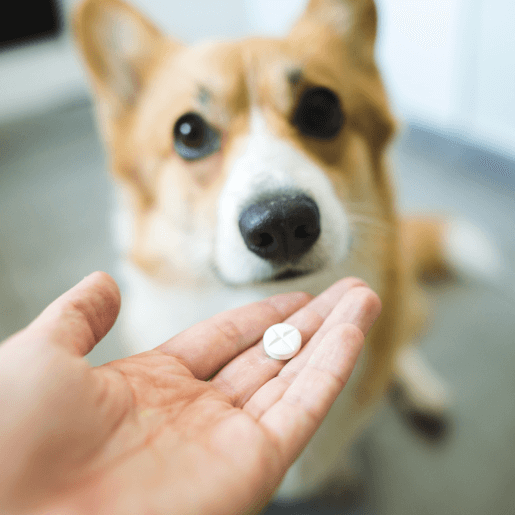Prednisone is a steroid medication commonly used in a variety of neurological diseases in dogs. Depending on the dose, it can act as an anti-inflammatory or immunosuppressive medication by binding to glucocorticoid receptors. Prednisone is one of the most frequently prescribed medications in veterinary neurology and may be used short-term or long-term, depending on your pet’s condition.
Prednisone should not be used in cats because they cannot efficiently convert it into its active form. Instead, Prednisolone, a similar steroid, is typically prescribed for feline patients.
For pets on long-term prednisone or prednisolone, comprehensive blood work (CBC, chemistry, and sometimes urinalysis with urine culture) is recommended every 3–6 months to monitor for potential side effects.
Dosing
Prednisone dosing varies significantly based on the disease being treated. It generally follows a tapering schedule. This means a higher dose is given initially, then gradually reduced to the lowest dose that effectively controls symptoms. Prednisone must also be weaned off gradually and should never be stopped abruptly, especially after prolonged use. Your neurologist will design a specific medication schedule for your pet.
Possible Side Effects
Prednisone often causes side effects, which are usually dose-dependent, which means higher doses generally have more side effects and lower doses generally have fewer side effects. In general, larger dogs tend to have more side effects:
- Increased thirst and urination: Allow unlimited access to water and access to the bathroom to prevent urinary accidents in the house
- Increased appetite: Monitor their food intake—just because they seem hungry doesn’t mean they should get extra food. Healthy treats like vegetables are a good option. Some pets may also develop inappropriate eating behaviors, such as chewing toys or getting into garbage.
- Panting: Excessive panting may occur, but it is usually not a cause for concern.
- Behavior changes: May include aggression, excitement, restlessness, or lethargy.
- Muscle wasting: Loss of muscle along the head, spine, and limbs will often occur with long-term usage. Some dogs may develop a “pot-bellied” look, with a noticeably larger belly. Although these may look unappealing, they are generally not dangerous.
- Liver changes: Long-term use may enlarge the liver or alter liver enzymes. Your neurologist will interpret bloodwork and advise if intervention is needed.
- Vomiting or diarrhea: May be mild or transient. If blood is present, contact your veterinarian immediately.
- Coat and skin changes: Dry, flaky skin, dull or thin coat, or slow hair regrowth may occur. Rarely, calcinosis cutis (hard crusts on the skin) can develop. If you notice hard crusts on your pet’s skin, contact Neuro Vet immediately, as prednisone will likely need to be tapered right away.
- Increased infection risk: Higher doses of steroids suppress the immune system; avoid high-concern areas like dog parks or stagnant water.
- Diabetes: Rarely, long-term high-dose use may cause diabetes mellitus, more commonly in cats. Regular bloodwork helps monitor this risk.
Additional Information
NSAIDs (e.g., Carprofen, Meloxicam, Deracoxib, Firocoxib) should not be given with prednisone, as this greatly increases the risk of gastrointestinal ulcers. If transitioning from one medication to the other, allow a 3–5 day washout period.
